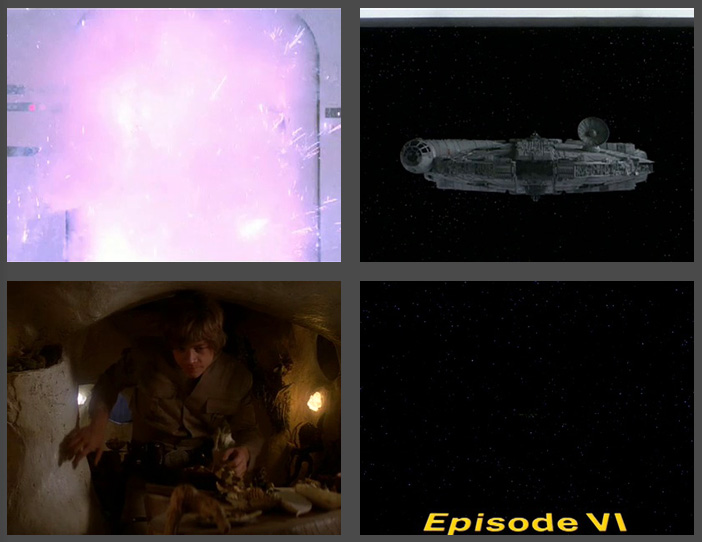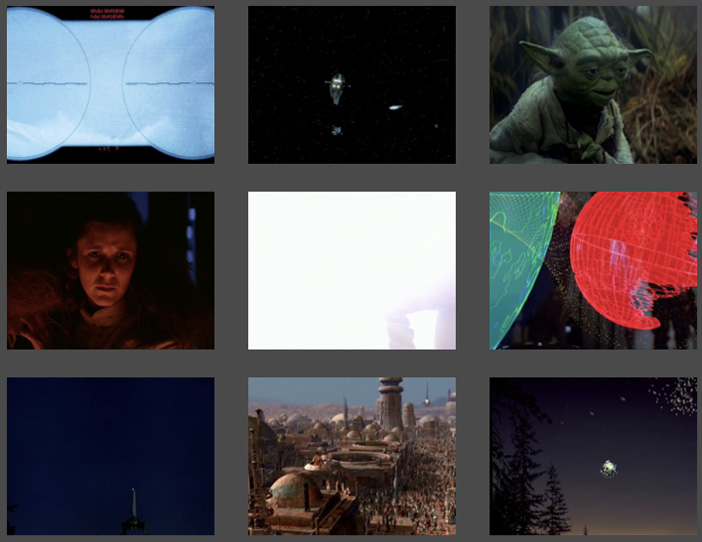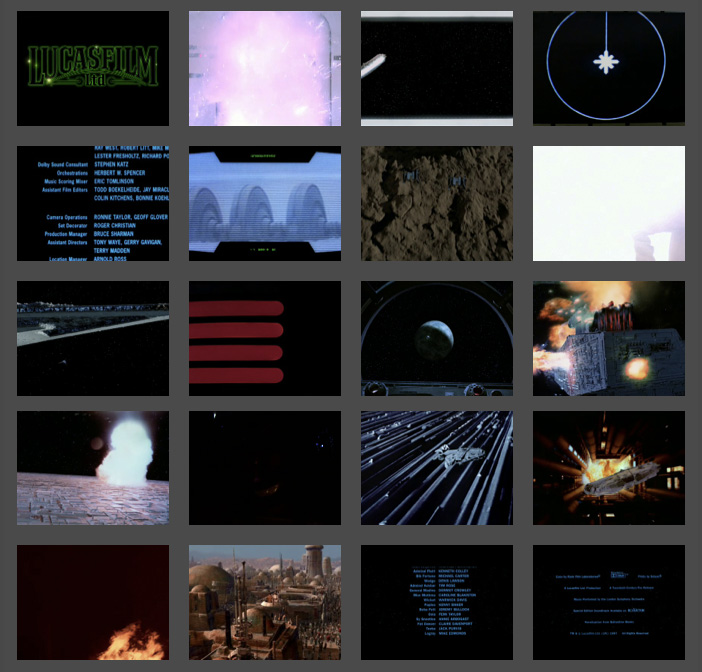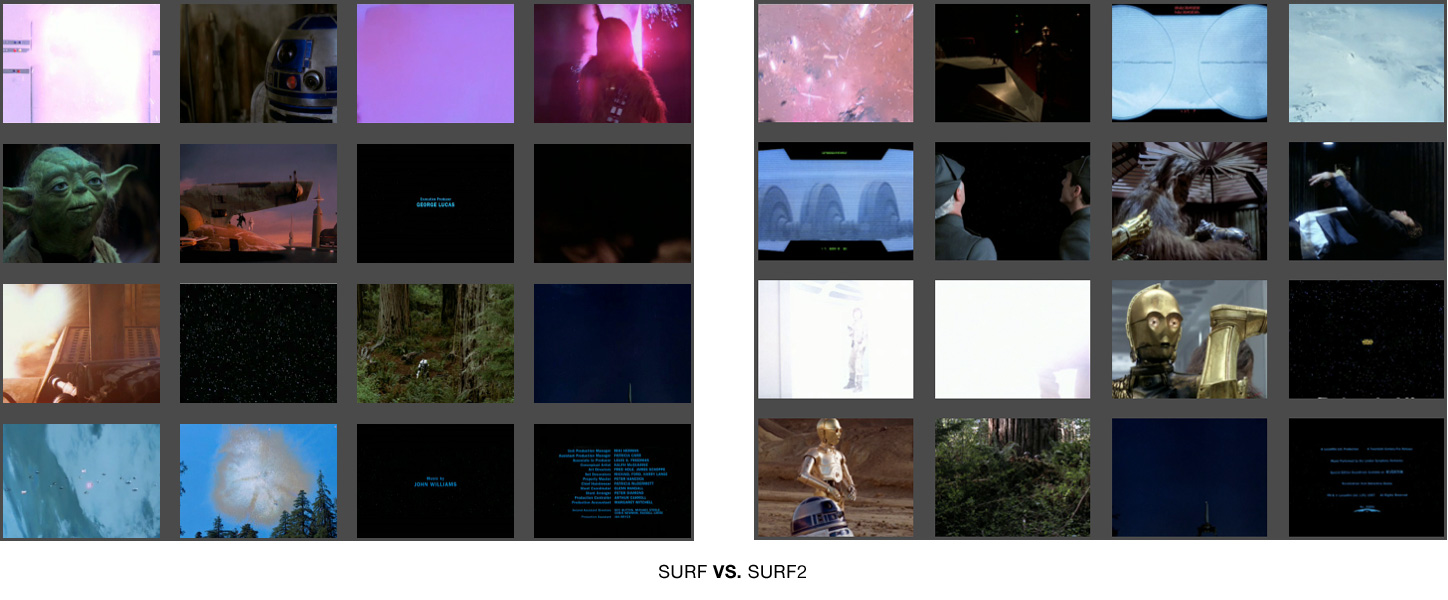Stare Wars: Using the Force (of Surveillance)
Last week I wrote about using software to scan the original Star Wars trilogy and construct a summary using 16 most surprising, or most telling, frames from the movie. This week, I generated other summaries of different sizes for comparison.
I wanted to make sure I had the best descriptor picked out for this content. I decided to compare the original setting of using SURF (Bag of Words) against SURF2. Both of these techniques use a ‘vocabulary’ file (with ‘words’ describing the images). For SURF, each chosen summary candidate image is compared against a vocabulary made only from the images picked out so far. For SURF2, each picked image is compared to a vocabulary file generated in advanced from all picked candiate images. In other words, SURF is like watching the films for the first time and making a summary as you go. SURF2 is like building a summary after a repeated viewing. Here are the two summaries side by side for comparison:
SURF did a better job summarizing the trilogy. See larger versions of the images here and here and judge for yourself.
Using SURF, I created summaries of other sizes, such as the 3 image summary:

The 3 image summary is not a subset of the 16. However, the 3 image and 4 image summaries share most of their content.
The 4 image summary incorporates most of the content of the 3 image set, but replaces the happy droid couple with the familiar purple door explosion and Luke Skywalker. Note the fact that it grabbed the other yellow text scroll, this time from Episode VI.

4 Image Summary of Star Wars has most of the content from the 3 image summary, plus Luke and the purple door explosion that precedes Darth Vader's appearance.
The 9 image summary is very rosy. Even though the galaxy-wide party montage was only shown for a few minutes of the final film, these senes take up two frames here (the last ones).

9 Frame Summary of Star Wars shows a pretty rosy story, filled with partying (well, at least for the last two frames!)
The 20 image summary is compositionally interesting but very dark. We see no characters but fire and explosions.

20 Image Summary of Star Wars. A very dark take on Star Wars. Notice the presistent, purple, exploding door. We see no human characters, an explosion, and a fire.
The 40 image summary shows the limitations of this technique. There are way to many (seven!) frames of blue text credits. However, Darth Vader finally makes the cut!

40 Image Summary of Star Wars. Darth Vader finally makes an appearance! We can see the limitations of the summarization technique due in part to the prevalence of blue credit text frames.
A friend pointed out the connection of this work to the work of Jason Savalon. I’m very intrigued by his choies of subjects and by the fine, painterly quality of the processed results. One difference is that my project is rooted in surveillance and augmented decision making, while Mr. Savalon’s projects seem to be geared towards human perception and memory.
Stare Wars: Summing up Star Wars with CV
“We are drowning in information but starved for knowledge.”
—John Naisbitt (Megatrends: Ten New Directions Transforming Our Lives)
I recently started collaborating with a small group of people. We are creating applications based on computer vision algorithms being developed by my friend Yogesh Girdhar.
I used some of this software to scan through my Estonian vacation footage from 2007. The result was a set of images-extracted from the video-that summarized the vacation. I turned hours of footage into a mere 12 stills. Its a more objective summary than I would have made. The software takes into account the entire composition (colors, textures, etc) of the frame, and faces get no special treatment. Matthew Williamson suggested that I use a film everybody knows. I decided to concatenate all three original Star Wars films into one 7 hour movie. The resulting summary of 16 images is here as well as embedded below.
Friends enjoyed me taking them through the summary image by image. It was great to hear them speculate on why the software picked certain frames. Some frames were picked because they were compositionally representative, but others because they were most rare.
Several art projects have questioned/challenge/subvert the supremacy of the surveillance gaze (In the event of Amnesia the city will recall…, Eyes of Laura, Sorting Daemon). Some projects explore the impact of surveillance on our society (Evidence Locker, The Dead Weight of Quarrel Hangs, Wafaa Bilal Domestic Tension). Other projects explore the idea of non-video surveillance (Makrolab, Broken Arrow). It was relevant to question who controls the cameras, but now everyone has access to cameras. Parallel, participatory surveillance creates a participatory panopticon. Despite the initial issues of access to the sensory data, computational constraints quickly become primary. As David Lyon, head of The New Transparency says in Surveillance Society: Monitoring Everyday Life “Today, the most important means of surveillance resides in computer power, which allows connected data to be stored, matched, retried, processed, marketed, and circulated.”
I’m excited about off-loading the difficult decisions about what is deviant to the robots.


1 comment